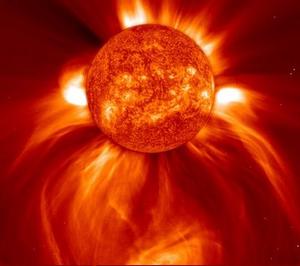Infrastructure protectionMassive solar storm leaves critical infrastructure largely unharmed
Last week critical infrastructure operator’s dodged a bullet when a colossal solar storm sent a flood of highly-charged protons hurtling at the earth; critical infrastructure operators had braced for the worst, but the storm only resulted in minimum disruptions to the world’s energy grid and transportation systems

A massive solar storm like this one caused little impact on earth // Source: times.si
Last week critical infrastructure operator’s dodged a bullet when a colossal solar storm sent a flood of highly-charged protons hurtling at the earth.
The storm, caused by a coronal mass ejection which sent balls of gas consisting of charged particles and magnetic field from the sun’s outer atmosphere, was more intense than anything recorded in the past seven years.
“It was pretty dramatic,” said Michael Hesse, the director of the Heliophysics Science Division at NASA’s Goddard Space Flight Center. “But it’s not the biggest that we’ve ever had - not by a long shot.”
Critical infrastructure operators had braced for the worst, but the storm only resulted in minimum disruptions to the world’s energy grid and transportation systems. Airlines were forced to reroute their northern flights to areas further south to minimize communication outages and increased radiation exposure, while some satellite operators reported additional noise on their systems.
“I think there has been made more of this event than perhaps is warranted,” said Rodney Viereck, a scientist at the National Oceanic and Atmospheric Administration’s Space Weather Prediction Center. “The solar flare itself was not that big, but it was really nicely positioned on the sun to direct the CME directly toward us. That’s what made it unique.”
Powerful solar storms are particularly problematic as they can knock out national power grids, short circuit home electronics, damage hospital equipment, destroy satellites, and severely disrupt communications equipment.
During these solar storms, the earth’s magnetic field is disturbed by the sun’s energetic protons which roil the earth’s upper atmosphere. Satellites, which orbit the earth in the upper atmosphere, must ride through the turbulence and often do not escape unharmed.
“It shortens the lifetime of solar cells on satellites, and it can damage electronics,” explained Hesse.
“The efficiency of solar panels takes a significant drop from each of these proton events,” added Viereck. “And almost every satellite has solar panels to provide electricity.”
In 2003, a powerful solar storm lasted for nearly two weeks creating ground-induced currents which damaged electrical grids and caused GPS systems to fail.
For some time, scientists have been warning about an increase in the intensity of solar storms as the sun’s cycle is set to peak in 2013 after one of its quietest periods in fifty years.
